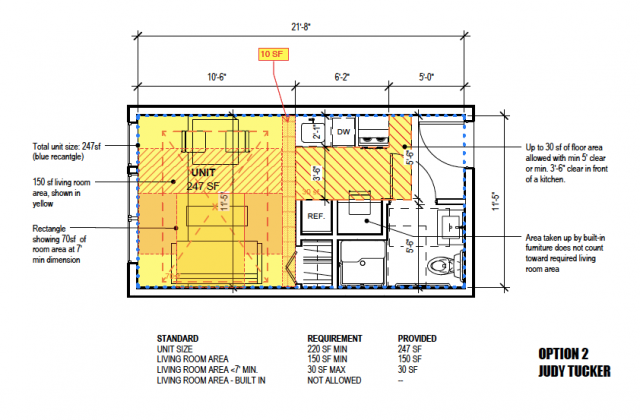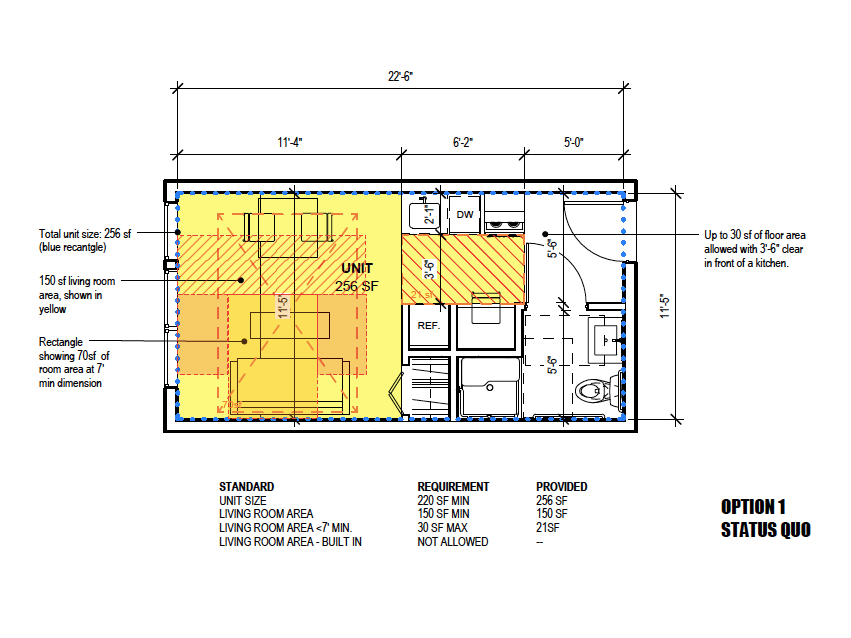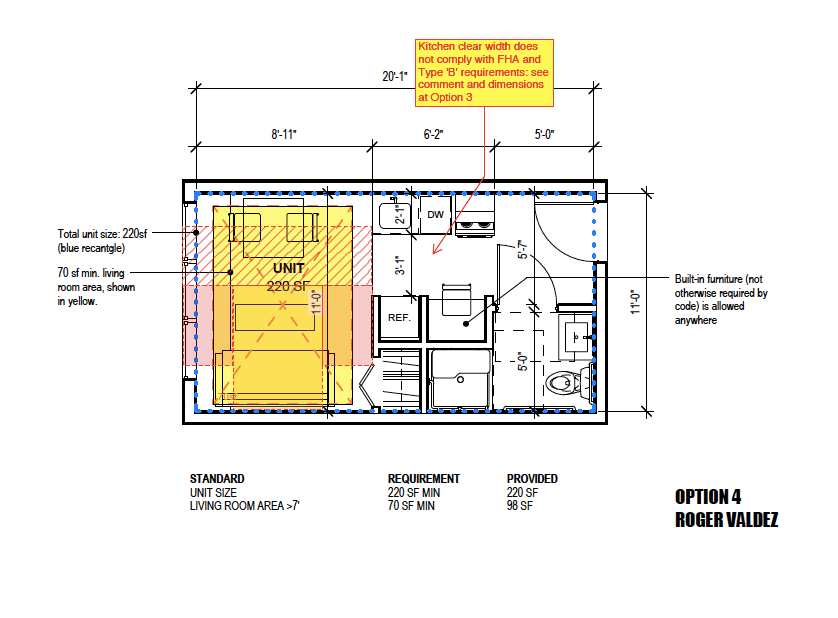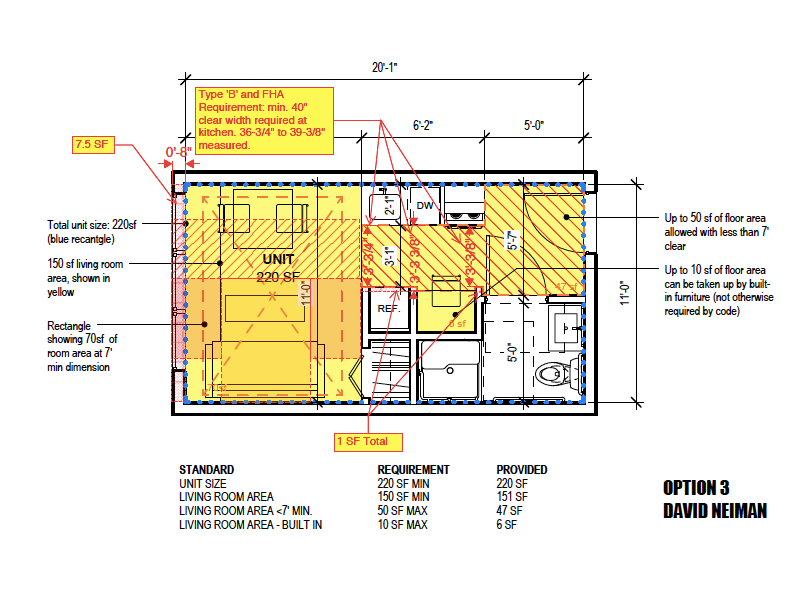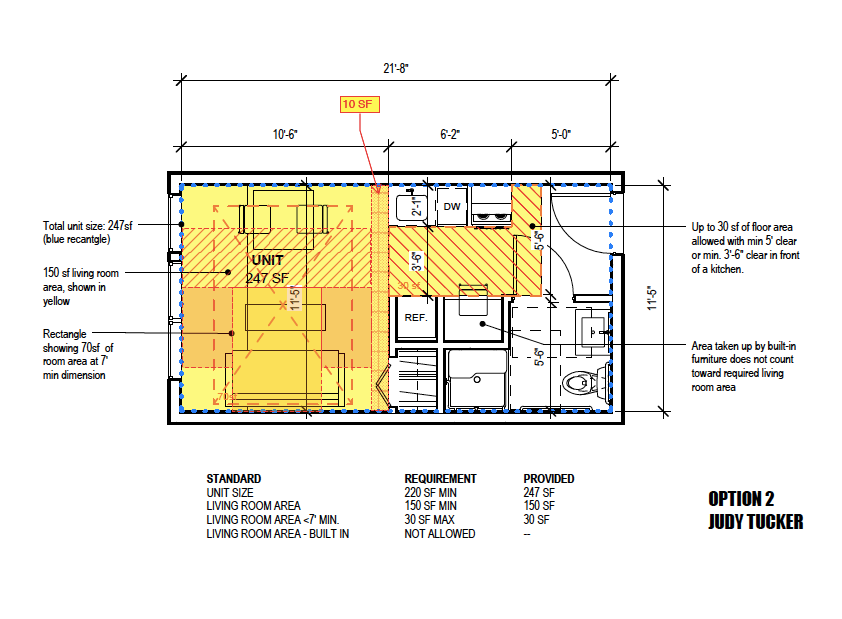CCAB Chooses Slightly More Flexibility for SEDUs
The months long progress over inches and feet at the Construction Code Advisory Board (CCAB) has come to a close and a recommendation has been made to modestly improve the friction between the land use code that allows a minimum sized unit for Small Efficiency Dwelling Units (SEDUs) of 220 square feet and the building code which has prescriptions that make achieving that size hard to do. When unit sizes get smaller it becomes more difficult to cram all the requirements mandated by the building code for minimum spaces for uses in the unit. Here is the status quo.
This option is forced actual unit sizes up into the 250 to 300 square foot range. Remember, the more units in a building the lower the rents. This fact was hotly disputed at CCAB and most members of the committee rejected the notion that when unit sizes are smaller and unit counts higher that rents are cheaper even though the price per square foot per unit is higher than bigger units. It’s just math. But this didn’t quite sink in. It was why I proposed the most flexible solution we could think of.
This option requires only 70 square feet of “living room” within the unit but keeps all the other basic requirements for other sizes. This option was rejected. In the parlance of Goldilocks, this option was too hot. Worries about bad design resulting or people eating on their beds ended up making most committee members uncomfortable. Then there is increases in density — simply more people being able to live in a building — that bothered neighborhood representatives.
David Neiman’s proposal was a little more nuanced keeping the 150 foot living room requirement but allowing more flexibility in its application in relation to other requirements and allowed for built in closets which wouldn’t be counted against the living room requirement.
We also considered a middle option of 100 square feet of living room as well. In the end, the recommendations spanned from mine, the most flexible and minimalist to the status quo. As the living room sizes got larger so did the possible exemptions to allow more flexibility in how the living room could be used (e.g. built ins or murphy beds).
In the end, the winner was what we called Option 2 by Judy Tucker, chair of the process.
This option is a modest increase in flexibility from the status quo, allowing 120 square feet of living room (min 7’ dimension) by allowing 30 square feet for built ins or other things.
If all of this seems confusing, it is, and I was there for all the meetings. Part of this is why this was a problem in the first place: developers, builders, and architects find it confusing too. The idea some of us had was just to make a change to make the building code and land use code line up in a way so very simple and very consistent that anyone could understand. While I don’t think we did that, my understanding is that Option 2 will end up allowing for smaller units, just not as small as the land use code allows, 220 square feet. There are just too many conflicts of things that need to be done in those 220 square feet to work. But adding up those 30 square feet means a few more units, and a few more people housed more affordably.
I suppose the ongoing disappointment is that the CCAB still seemed to believe in spite of the math, that the smallness of units has little to do with the price of rent but trying to cram more units to generate additional profits. The sense from the group, made up of professionals from the world of design and engineering, is that allowing too much flexibility would lead to bad design and people being forced to live in ways that are inhuman; this is a view shared with the neighborhood opponents. In the case of the neighborhoods it truly is a red herring; they really don’t care about the conditions, they mention them to create a state of affairs where those units won’t happen at all. The professionals, I think, really do believe they are looking out for future, suffering tenants.
In the end, Tucker ran a very fair and, I think, open process. She was very patient with people’s frustrations and did manage to keep steering us back from the big philosophical and economic questions to the Goldilocks question: which change to the rules would result in a mix of minimums and flexibility that is “just right.” For now, we have our answer.
Smart Growth Seattle on Seattle Forecast Panel
Bisnow is hosting an event called SEATTLE FORECAST 2017: The Roadmap For Seizing 2017 In The Emerald City and I will be on the panel as the “Supply Champion.” The panel is at the Four Seasons this Thursday morning at 8AM. What’s Bisnow? I’ll let them explain:
We’re intensely curious about commercial real estate. If this were high school, we’d definitely get beat up. But now we’re all adults. And we’re here to help you be curious (and nerd out) about real estate. Want to know about the hottest new developer in Brooklyn? We got you! Up late wondering if 3D printing building materials actually works? We get it.
I’m looking forward to it, and assuming I survive a dental procedure this morning, I will be ready to discuss the impact of regulation on how our industry is trying to meet housing demand. The other panelists are Martin Selig who I believe is a supporter of the so called “Grand Bargain” and Councilmember Rob Johnson who is getting lots of heat right now for trying to do the right thing with up zones in the U District. Peter Otelle from Paar Development will be keeping the conversation on track as moderator.
I’m going to stick around for the conversation about foreign investment, a concern that is a red herring, but will still influence opinion and maybe policy. Join the fun if you can on Thursday.
President’s Day: Trump No Reason for Local Leaders to Wage Class Warfare
Here’s a recent Facebook post by Seattle City Councilmember Kshama Sawant:
It’s time for politicians to move beyond platitudes to action. If Seattle is a sanctuary city, elected officials need to take radical measures to fight Trump’s attacks. The Mayor should not deploy police against peaceful protesters, but instead use police to shield immigrants from ICE raids! Sanctuary also means affordability: Tax big developers and fight for rent control to make our city affordable for all!
Here’s what I wrote right after the election at Forbes:
Seattle has been the scene lately of loud and noisy protests against the coming Trump administration, and this opposition is in no small part because of President-Elect Trump’s views on immigration. He wants to deport people and wall new people out of our country. However, the very people in the streets of Seattle who oppose this policy, usually, when it comes to housing and growth policy here, are part of an all too familiar pattern of insular and ingrown almost xennophobic protectionism that seems to run counter with the self-proclaimed leftist hegemony in the city. It’s a pattern sure to raise a barrier for new people who want to live in the city, a barrier of high housing prices that might as well be a wall (check out Saturday Night Live’s take on this effect they call “The Bubble“).
My comments were later mimicked by Councilmember Rob Johnson when he compared angry neighborhood opposition to Trump’s wall building. I had to point out all over social media that I had said this first, not because of my ego, but because I want to remind people I know what I’m talking about. More importantly, what I say is often discredited automatically until someone else says it. But it doesn’t make it any less true. I’ve called it the Cassandra effect.
So these are the two ways in which the Trump thing is going to play out locally. On the one hand, the somewhat inchoate mob of socialists and angry and mostly white and entitled single-family homeowners will crowd around Sawant in the street in front of various public buildings and shake their fists, grit their teeth, and stomp their feet. Local politicians suffering from chronic Sally Field Syndrome will jump in front of parades, file appeals, make declarations, and threaten to disobey the Federal government all to the cheers of the bitter mob. While this is what Trump himself might call, “Sad!” in a Tweet, it’s more concerning that meets the eye.
Politicians can express in what they do both the highest aspirations that people have; their speeches and actions can inspire and when they have vision they can assuage anger, ameliorate anxiety, and show people that what their own fears and prejudices make impossible can be done if they’d let go of those walls around themselves. It is physically painful to watch Robert Kennedy’s speech at the time of the assassination of Martin Luther King Jr. Here’s a man who spoke from the heart to the heart, quoting Greek poetry, to a group of black people filled with legitimate rage and pain.
What we need in the United States is not division; what we need in the United States is not hatred; what we need in the United States is not violence and lawlessness, but is love, and wisdom, and compassion toward one another, and a feeling of justice toward those who still suffer within our country, whether they be white or whether they be black.
So I ask you tonight to return home, to say a prayer for the family of Martin Luther King — yeah, it’s true — but more importantly to say a prayer for our own country, which all of us love — a prayer for understanding and that compassion of which I spoke.
We can do well in this country. We will have difficult times. We’ve had difficult times in the past, but we — and we will have difficult times in the future. It is not the end of violence; it is not the end of lawlessness; and it’s not the end of disorder.
But the vast majority of white people and the vast majority of black people in this country want to live together, want to improve the quality of our life, and want justice for all human beings that abide in our land.
And let’s dedicate ourselves to what the Greeks wrote so many years ago: to tame the savageness of man and make gentle the life of this world. Let us dedicate ourselves to that, and say a prayer for our country and for our people.
It hurts because we are in one of “those difficult times,” and Kennedy himself was gunned down only months later. We never had a chance to see him as President. So today, instead of his steady but breaking voice, speaking from his own heartache and pain from the loss of his brother, to people that had lost their own leader, we have a smallness of mind and lack of vision from local leaders who are taking fear and anxiety and bending it to their own narrow and dangerous agenda.
All the marching and Trump obsession lately has me with the feeling of being trapped behind the lines. I see people casually talking about secession from the union and urging local law enforcement to get into altercations with federal law enforcement. It’s as if the people never learned about the Nullification Crisis or our Civil War in school. The bravado from local leaders, including even faith leaders, is truly disheartening.
I am an adherent to the sense of conservatism articulated by Edmund Burke by his actions in Parliament as well as his words, here from Reflections on the Revolution in France:
The constituent parts of a state are obliged to hold their public faith with each other and with all those who derive any serious interest under their engagements, as much as the whole state is bound to keep its faith with separate communities. Otherwise competence and power would soon be confounded and no law be left but the will of a prevailing force. On this principle the succession of the crown has always been what it now is, an hereditary succession by law; in the old line it was a succession by the common law; in the new, by the statute law operating on the principles of the common law, not changing the substance, but regulating the mode and describing the persons. Both these descriptions of law are of the same force and are derived from an equal authority emanating from the common agreement and original compact of the state, communi sponsione republican [(the assent of the commons)], and as such are equally binding on king and people, too, as long as the terms are observed and they continue the same body politic (page 18).
It is worth noting that Burke was a supporter of the American Revolution that uprising was a demand for what colonists felt they were due under the English Constitution and common law, not an abrogation of tradition and order for the sake of just making up something new. The French Revolution, on the other hand, of which Burke was critical, stoked class warfare and simply threw out everything out at once, leaving nothing standing. It’s tempting when one is frustrated with a creaky old system of government to long for cutting down all the old rules. One of the best articulations of why this is a bad idea are the words put into the mouth of Thomas More in the play A Man for All Seasons:
It can be a challenge to be calm during times of social disorder. It is easy to push back against a system producing results we don’t like. As a Hayekian, I feel the frustration with our fussy land use laws, an overgrown thicket of amendment by reference, confusing, contradictory, and harmful to the people of this city, laws without aspiration for what is good but only worried about stopping what might be bad. God, how I’d love to cut those down all those laws, every last one of them! With a chain saw. And the Council keeps adding more and more to the mess in the name of social justice and trying to help lower prices by adding costs, to increase access to affordable housing by imposing schemes that will make it less accessible. How sweet it would be to slice through all that to get to the “devil himself” hiding in the bushes of the code.
However, that would make me no better than Sawant, Trump, or the angry mob whether they are urging nullification or fighting microhousing or Detached Accessory Dwelling Units, or pushing for the sweeping away homeless people in their tents or their cars. Mobs like that always appeal to “the will of a prevailing force.”
It may take awhile, but those of us who are working for a better world can’t rely on revolution or abrogation of a system of laws that produce outcomes we may not like. And one election or candidate won’t undo the damage. But we have to play the long game, patiently and with intention. So I turn once again to the land from whence all blessings flow, England, and my fellow Burkian John Lennon. I have to believe it’s going to be all right. It will be.
The featured image is called, “Nullification crisis: John C. Calhoun reaching for Despotism,” and is a lithograph from Endicott and Sweet, lithographers in New York City, produced in about 1833.
Will City Pay Attention to Data on Homeless Resources or Just Keep Sweeping?
Someone sent me a report about homelessness by consultant group Focus Strategies. I agree with the substance and approach.
The report called, Seattle/King County: Homeless System Performance Assessment and Recommendations with Particular Emphasis on Single Adults was commissioned by United Way of King County, the City of Seattle, and King County.
The most compelling part of the report says that solving the homeless problem is largely doable with bold action and organizing existing resources better.
Seattle/King County has sufficient emergency shelter capacity to shelter all unsheltered single adult and family households by the end of 2017 by combining three initiatives: (1) eliminating low and moderately performing transitional housing (TH) projects; (2) reaching recommended system and program performance targets; and (3) implementing a well-functioning coordinated entry and diversion system (page 42).
It’s a smart and well done report and here are my thoughts.
I’ve visited with and written about the people working on these issues in Utah and Massachusetts (see Utah’s Strides On Chronic Homelessness Rely On Better … – Forbes and Massachusetts Tries A New Solution For Chronic … – Forbes). In both states, the first step was to define the highest cost and most chronic part of the problem. The report does that by focusing on about 5,000 households. And I appreciate the effort to prioritize current programs and funding to case manage and work these more challenging situations into more permanent and stable solutions.
The hard part is trying to get the Seattle City Council to, “Act with Urgency and Boldness” which the report has as one of its first recommendations. The City Council doesn’t know how to be bold unless faced with an angry mob with a clear and publicly unpopular antagonist like developers or landlords. Without an enemy to flay and a mob to cheer, they simply are incapable of making decisions that solve real problems.
Having said that, and in response to the report, I would enthusiastically support,
- The City needs to stop sweeps of homeless camps immediately — it makes no sense to destabilize households that have at least put together some kind of housing solution in the right of way. The City needs to work with these people to identify their issues and move them along a continuum of services. Many of these households are likely to be among the 5000 in the UW report; (see City Of Seattle Should Cooperate With Residents Of The Jungle – Forbes)
- The City must enhance its approach to people who are living in vehicles, share data with social workers and service providers working with those households, and create a better and more transparent protocol and modest funding stream for solving these shorter term problems. Too often these households lose their homes when they get towed away for lack of payment of tickets or for other parking infractions. Again, many of these households may be among the 5,000 in the UW report. (see: Home Is Where My Car Is: Murray’s Sledgehammer Approach … – Forbes)
- I agree with the much smarter and experienced people on what they are suggesting as the starting point (D.2.d, page 42 and following) for using resources.
- Recognize that the solution for these families is not going to be the construction of free standing units of housing;
- Levy dollars and other public resources should be directed to vouchers and cash payments as much as possible rather than adding these households to waiting lists for subsidized housing
- Prevention is important, and the Council needs to stop doing herm to the Multifamily Tax Exemption (MFTE) program by increasing inclusion rates and lowering Area Median Income (AMI) requirements. This doesn’t create more housing for poorer households, but fewer homes at 60 percent of AMI. If the Council wants to expand the reach of that program into lower levels of income it should expand the tax exemption and make it easier to use. This would prevent many households from having housing problems turn into housing crisis
- Explore the use of social investment capital by creating a better assessment of the costs of the 5000 households to taxpayers and then bond against the future reductions of those costs. In other words, raise private capital to address the problems now, then pay back the investors using the realized savings as the problem is solved. This is a HALA recommendation. see Tracking HALA: Ending Homelessness with Social Impact Bonds …
As I said, anyone using data and common sense is going to come to the conclusion that we can solve much of the homeless issue but it will take 90 percent of those resources to solve the last 10 percent. Any case manager or social worker will say that to the Mayor if he was willing to listen. Utah has had a lot of success with this approach of putting lots of effort into the people that are known to the system and taking time to move them along the continuum. Throwing away their tents and towing away their cars doesn’t do that, in fact it does the exact opposite perpetuating the problem.
This city seems obsessed with hating Trump while trying to wish and sweep away homelessness and lower prices by adding regulation and costs and taxes and fees to market rate housing and taking the money generated from taxes and giving it to non-profit developers who build $500,000 units that take 4 or 5 years to build. That doesn’t make any sense. What does make sense is taking this report seriously and doing something to implement the solutions it offers.
This Week in Olympia: Another Cash Grab by Non-Profit Housers
Late last week I spotted a post on Facebook that I really couldn’t believe. The non-profit housing group the Housing Development Consortium (HDC) and Futurewise are pushing to use funds generated from the Real Estate Excise Tax (REET) for affordable housing. The legislation, House Bill 1797
Consider the facts about REET and non-profit housing in Seattle.
- The City of Seattle collected about $73.5 million in 2015
- Last year two affordable housing projects opened with a total of 200 units at a price of $92 million
- Had Seattle allocated ALL of the REET funding for those projects it would have fallen short by almost $20 million
- Funds from REET go to the Cumulative Reserve Fund to pay for capital infrastructure
- Where would those infrastructure projects get funding from after they’re diverted to expensive subsidized housing?
- One of the biggest demands among angry neighbors is impact fees in Seattle, something that we have argued is not needed because lots of infrastructure is paid for with CRF.
The 2017-2018 Proposed Budget appropriates $96.1 million from the Cumulative Reserve Subfund (CRS) in 2017 and $80.6 million in 2018 with approximately 80% of those appropriations backed by the two REET funds. Individual projects and programs supported by CRS resources are described in the departmental sections of this document and in the 2017-2022 Proposed Capital Improvement Program (CIP). A supporting summary schedule provides the amounts for the various City departments utilizing these resources.
